第四章 Store类
Store类定义在VUEX源码的294 ~ 775 行,是VUEX中最后定义的、最重要的类,也是我们实际上最后使用的类。我们来具体看看它的内容。
4.1 成员属性和成员函数
Store类的成员属性主要有下面几个:
- _committing。标识是否正提交。类型Boolean.
- _actions。储存actions。类型Object。
- _actionSubscribers。存储actions的订阅者。类型Array。
- _mutations。存储mutations。类型Object。
- _wrappedGetters。存储wrapped后的Getters。类型Object。
- _modules。存储模块链。是一个ModuleCollection实例。
- _modulesNamespaceMap。存储带命名空间的modules。类型Object。
- _subscribers。存储订阅者。类型Object。
- _watcherVM。存储Vue实例。
- strict。标识是否strict模式。类型Boolean。
其源码定义在296 ~ 362 Store类的构造函数中,我们来看看:
var Store = function Store (options) {
var this$1 = this;
if ( options === void 0 ) options = {};
// Auto install if it is not done yet and `window` has `Vue`.
// To allow users to avoid auto-installation in some cases,
// this code should be placed here. See #731
if (!Vue && typeof window !== 'undefined' && window.Vue) {
install(window.Vue);
}
{
assert(Vue, "must call Vue.use(Vuex) before creating a store instance.");
assert(typeof Promise !== 'undefined', "vuex requires a Promise polyfill in this browser.");
assert(this instanceof Store, "Store must be called with the new operator.");
}
var plugins = options.plugins; if ( plugins === void 0 ) plugins = [];
var strict = options.strict; if ( strict === void 0 ) strict = false;
var state = options.state; if ( state === void 0 ) state = {};
if (typeof state === 'function') {
state = state() || {};
}
// store internal state
this._committing = false;
this._actions = Object.create(null);
this._actionSubscribers = [];
this._mutations = Object.create(null);
this._wrappedGetters = Object.create(null);
this._modules = new ModuleCollection(options);
this._modulesNamespaceMap = Object.create(null);
this._subscribers = [];
this._watcherVM = new Vue();
// bind commit and dispatch to self
var store = this;
var ref = this;
var dispatch = ref.dispatch;
var commit = ref.commit;
this.dispatch = function boundDispatch (type, payload) {
return dispatch.call(store, type, payload)
};
this.commit = function boundCommit (type, payload, options) {
return commit.call(store, type, payload, options)
};
// strict mode
this.strict = strict;
// init root module.
// this also recursively registers all sub-modules
// and collects all module getters inside this._wrappedGetters
installModule(this, state, [], this._modules.root);
// initialize the store vm, which is responsible for the reactivity
// (also registers _wrappedGetters as computed properties)
resetStoreVM(this, state);
// apply plugins
plugins.forEach(function (plugin) { return plugin(this$1); });
if (Vue.config.devtools) {
devtoolPlugin(this);
}
};
该类会首先检查我们在声明Store实例的时候有没有传递options参数,如果没有则会初始化为空对象{}。然后会检查Vue有没有定义,如果Vue没有定义,并且window上已经有挂载Vue,那么会安装Vue,否则告警:
// Auto install if it is not done yet and `window` has `Vue`.
// To allow users to avoid auto-installation in some cases,
// this code should be placed here. See #731
if (!Vue && typeof window !== 'undefined' && window.Vue) {
install(window.Vue);
}
{
assert(Vue, "must call Vue.use(Vuex) before creating a store instance.");
assert(typeof Promise !== 'undefined', "vuex requires a Promise polyfill in this browser.");
assert(this instanceof Store, "Store must be called with the new operator.");
}
这段代码可以确保Vue被且仅被一次安装。Vue是全局声明在VUEX源码中的294行:
var Vue; // bind on install
而如果我们在页面使用了Vue(不管是脚本引入<script src="./vue.js"></script>还是node引入模式),在window上都会挂载一个Vue:

而安装Vue的install方法定义在VUEX源码的777 ~ 788行,主要就是给全局声明的Vue赋值,然后调用了applyMixin执行混入:
function install (_Vue) {
if (Vue && _Vue === Vue) {
{
console.error(
'[vuex] already installed. Vue.use(Vuex) should be called only once.'
);
}
return
}
Vue = _Vue;
applyMixin(Vue);
}
applyMixin定义在VUEX源码的12 ~ 29行,它的主要目的是确保在Vue的beforeCreate钩子函数中调用vuexInit函数,当然更具Vue版本差异实现方法也有差异,因为我们主要针对>2的版本,所以这里只看版本>2时的情况:
var applyMixin = function (Vue) {
var version = Number(Vue.version.split('.')[0]);
if (version >= 2) {
Vue.mixin({ beforeCreate: vuexInit });
} else {
// override init and inject vuex init procedure
// for 1.x backwards compatibility.
var _init = Vue.prototype._init;
Vue.prototype._init = function (options) {
if ( options === void 0 ) options = {};
options.init = options.init
? [vuexInit].concat(options.init)
: vuexInit;
_init.call(this, options);
};
}
/**
* Vuex init hook, injected into each instances init hooks list.
*/
function vuexInit () {
var options = this.$options;
// store injection
if (options.store) {
this.$store = typeof options.store === 'function'
? options.store()
: options.store;
} else if (options.parent && options.parent.$store) {
this.$store = options.parent.$store;
}
}
};
在该函数内部定义了vuexInit函数,该函数的主要作用是在Vue的实例上挂载$store:
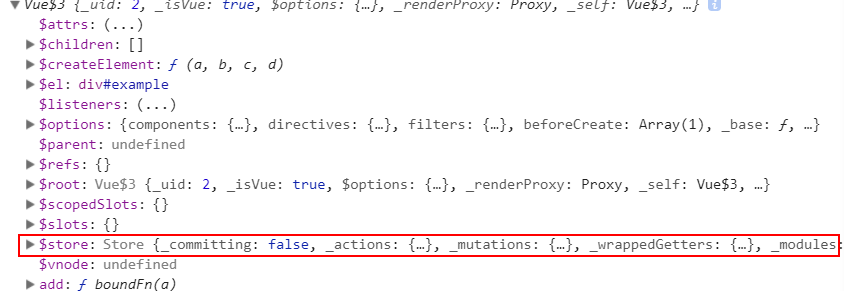 回过头来继续看Store构造函数,在执行完install之后,它会对构造函数的options参数进行检查,当不合法时会给出默认值:
回过头来继续看Store构造函数,在执行完install之后,它会对构造函数的options参数进行检查,当不合法时会给出默认值:
var plugins = options.plugins; if ( plugins === void 0 ) plugins = [];
var strict = options.strict; if ( strict === void 0 ) strict = false;
var state = options.state; if ( state === void 0 ) state = {};
if (typeof state === 'function') {
state = state() || {};
}
这里面有两点需要注意:
- 判断undefiend采用的是void 0形式判断,这是一种非常好的判断方式。
- state属性并不一定需要是个对象,它也可以是产生对象的工厂函数。这个我们在第二章Module类中已经分析过。
接下来就是成员属性的定义:
// store internal state
this._committing = false;
this._actions = Object.create(null);
this._actionSubscribers = [];
this._mutations = Object.create(null);
this._wrappedGetters = Object.create(null);
this._modules = new ModuleCollection(options);
this._modulesNamespaceMap = Object.create(null);
this._subscribers = [];
this._watcherVM = new Vue();
再接下来就是成员函数dispatch和commit的定义,这个我们在下一节详细讲述。
接下来会执行installModule函数:
// init root module.
// this also recursively registers all sub-modules
// and collects all module getters inside this._wrappedGetters
installModule(this, state, [], this._modules.root);
英文的注释已经描述的很详细了,installModule会初始化根模块,并递归地注册子模块,收集所有模块的Getters放在_wrappedGetters属性中。installModule是一个全局函数,定义在VUEX源码的577 ~ 617 行:
function installModule (store, rootState, path, module, hot) {
var isRoot = !path.length;
var namespace = store._modules.getNamespace(path);
// register in namespace map
if (module.namespaced) {
store._modulesNamespaceMap[namespace] = module;
}
// set state
if (!isRoot && !hot) {
var parentState = getNestedState(rootState, path.slice(0, -1));
var moduleName = path[path.length - 1];
store._withCommit(function () {
Vue.set(parentState, moduleName, module.state);
});
}
var local = module.context = makeLocalContext(store, namespace, path);
module.forEachMutation(function (mutation, key) {
var namespacedType = namespace + key;
registerMutation(store, namespacedType, mutation, local);
});
module.forEachAction(function (action, key) {
var type = action.root ? key : namespace + key;
var handler = action.handler || action;
registerAction(store, type, handler, local);
});
module.forEachGetter(function (getter, key) {
var namespacedType = namespace + key;
registerGetter(store, namespacedType, getter, local);
});
module.forEachChild(function (child, key) {
installModule(store, rootState, path.concat(key), child, hot);
});
}
代码开始会判断是否是根模块,并且会获取模块对应的命名空间,如果该模块有namespace属性,则在_modulesNamespaceMap属性上以命名空间为key保存该模块:
var isRoot = !path.length;
var namespace = store._modules.getNamespace(path);
// register in namespace map
if (module.namespaced) {
store._modulesNamespaceMap[namespace] = module;
}
下面这个貌似意思是将该模块的state以命名空间为key挂载父模块的state上,形成state链,这个过程是为了后面使用getNestedState函数查找对应命名空间的state:
// set state
if (!isRoot && !hot) {
var parentState = getNestedState(rootState, path.slice(0, -1));
var moduleName = path[path.length - 1];
store._withCommit(function () {
Vue.set(parentState, moduleName, module.state);
});
}
我们来看一个根store上挂载namespaced的a模块,a模块又挂载namespaced的c模块的例子,此时根store的state长这样:
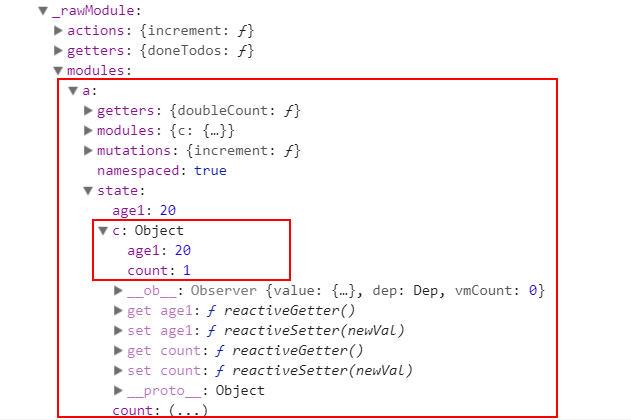
回过头来看installModule,接下来是拿到本地的上下文:
var local = module.context = makeLocalContext(store, namespace, path);
本地上下文是什么意思呢?意思就是说,dispatch, commit, state, getters都是局部化了。我们知道store的模块是有命名空间的概念的,要想操作某一层级的东西,都是需要用命名空间去指定的。如果不使用命名空间,操作的是根级别的。所以本地上下文是指的就是某个模块的上下文,当你操作dispatch, commit, state, getters等的时候,你实际上直接操作的某个模块。
这个看似复杂的东西是如何实现的呢?其实它只不过是个语法糖,它内部也是通过逐级查找,找到对应的模块完成的。我们来看看这个makeLocalContext的实现,它定义在VUEX源码的618 ~ 675 行:
/**
* make localized dispatch, commit, getters and state
* if there is no namespace, just use root ones
*/
function makeLocalContext (store, namespace, path) {
var noNamespace = namespace === '';
var local = {
dispatch: noNamespace ? store.dispatch : function (_type, _payload, _options) {
var args = unifyObjectStyle(_type, _payload, _options);
var payload = args.payload;
var options = args.options;
var type = args.type;
if (!options || !options.root) {
type = namespace + type;
if ("development" !== 'production' && !store._actions[type]) {
console.error(("[vuex] unknown local action type: " + (args.type) + ", global type: " + type));
return
}
}
return store.dispatch(type, payload)
},
commit: noNamespace ? store.commit : function (_type, _payload, _options) {
var args = unifyObjectStyle(_type, _payload, _options);
var payload = args.payload;
var options = args.options;
var type = args.type;
if (!options || !options.root) {
type = namespace + type;
if ("development" !== 'production' && !store._mutations[type]) {
console.error(("[vuex] unknown local mutation type: " + (args.type) + ", global type: " + type));
return
}
}
store.commit(type, payload, options);
}
};
// getters and state object must be gotten lazily
// because they will be changed by vm update
Object.defineProperties(local, {
getters: {
get: noNamespace
? function () { return store.getters; }
: function () { return makeLocalGetters(store, namespace); }
},
state: {
get: function () { return getNestedState(store.state, path); }
}
});
return local
}
该函接受根级别的store、命名空间、模块路径作为参数,然后声明一个local对象,分别局部化dispatch, commit, getters , state。我们来分别看一下:
局部化dispatch:
dispatch局部化时,首先判断有没有命名空间,如果没有则直接使用根级别的dispatch方法,如果有,则重新定义该方法:
function (_type, _payload, _options) {
var args = unifyObjectStyle(_type, _payload, _options);
var payload = args.payload;
var options = args.options;
var type = args.type;
if (!options || !options.root) {
type = namespace + type;
if ("development" !== 'production' && !store._actions[type]) {
console.error(("[vuex] unknown local action type: " + (args.type) + ", global type: " + type));
return
}
}
return store.dispatch(type, payload)
}
重新定义其实只不过是规范化参数,将参数映射到指定命名空间的模块上,是调用unifyObjectStyle来完成的,它定义在VUEX源码的763 ~ 775 行,我们来看看它的实现:
function unifyObjectStyle (type, payload, options) {
if (isObject(type) && type.type) {
options = payload;
payload = type;
type = type.type;
}
{
assert(typeof type === 'string', ("Expects string as the type, but found " + (typeof type) + "."));
}
return { type: type, payload: payload, options: options }
}
规范化参数其实是和官方文档关于dispatch的描述是呼应的,我们引用一下官方的表述:
Actions 支持同样的载荷方式和对象方式进行分发:
// 以载荷形式分发 store.dispatch('incrementAsync', { amount: 10 }) // 以对象形式分发 store.dispatch({ type: 'incrementAsync', amount: 10 })
可以看出unifyObjectStyle只不过是把载荷形式的分发转换成了对象形式的分发,这种情况下的options其实是undefined。
回过头来继续看dispatch的局部化过程。当规范化参数会分别拿到规范化的参数,然后对于非根级别,则给type加上命名空间:
var payload = args.payload;
var options = args.options;
var type = args.type;
if (!options || !options.root) {
type = namespace + type;
if ("development" !== 'production' && !store._actions[type]) {
console.error(("[vuex] unknown local action type: " + (args.type) + ", global type: " + type));
return
}
}
最后还是调用根级别的dispatch来完成分发:
return store.dispatch(type, payload)
局部化commit:
commit的局部化如下:
commit: noNamespace ? store.commit : function (_type, _payload, _options) {
var args = unifyObjectStyle(_type, _payload, _options);
var payload = args.payload;
var options = args.options;
var type = args.type;
if (!options || !options.root) {
type = namespace + type;
if ("development" !== 'production' && !store._mutations[type]) {
console.error(("[vuex] unknown local mutation type: " + (args.type) + ", global type: " + type));
return
}
}
store.commit(type, payload, options);
}
};
整个过程和dispatch的局部化过程几乎一模一样,这里我们就不再赘述。
局部化Getters:
Getters的局部化时在前述的local对象上定义getters属性,并重新定义该属性的get函数:
getters: {
get: noNamespace
? function () { return store.getters; }
: function () { return makeLocalGetters(store, namespace); }
},
其主要思路就是:没有命名空间的时候直接拿根级别的getters,有命名空间的时候拿对应模块上的getters。这其中用到了makeLocalGetters函数,它定义在VUEX源码的677 ~ 698 行,我们来看看它的实现:
function makeLocalGetters (store, namespace) {
var gettersProxy = {};
var splitPos = namespace.length;
Object.keys(store.getters).forEach(function (type) {
// skip if the target getter is not match this namespace
if (type.slice(0, splitPos) !== namespace) { return }
// extract local getter type
var localType = type.slice(splitPos);
// Add a port to the getters proxy.
// Define as getter property because
// we do not want to evaluate the getters in this time.
Object.defineProperty(gettersProxy, localType, {
get: function () { return store.getters[type]; },
enumerable: true
});
});
return gettersProxy
}
我们只需要遍历根级别store的getters属性,找到对应的命名空间,然后代理对它的访问就可以了。我们可以先来看一个例子以及根级别上getters的内容,相信对理解上述代码会更用帮助:
const moduleC = {
namespaced: true,
state: { count: 1, age1: 20 },
mutations: {
increment (state) {
// 这里的 `state` 对象是模块的局部状态
state.count++
}
},
getters: {
doubleCount (state) {
return state.count * 2
}
}
}
const moduleA = {
namespaced: true,
state: { count: 1, age1: 20 },
getters: {
doubleCount (state) {
return state.count * 2
}
},
modules: {
c: moduleC
}
}
const moduleB = {
namespaced: true,
state: { count: 1, age1: 20 },
getters: {
doubleCount (state) {
return state.count * 2
}
}
}
const store = new Vuex.Store({
state() {
return {
count: 0,
todos: [
{ id: 1, text: '...', done: true },
{ id: 2, text: '...', done: false }
]
}
},
getters: {
doneTodos: state => {
return state.todos.filter(todo => todo.done)
}
},
modules: {
a: moduleA,
b: moduleB
}
})
var vm = new Vue({
el: '#example',
data: {
age: 10
},
store,
mounted() {
console.log(this.count)
this.localeincrement('hehe')
console.log(this.count)
},
// computed: Vuex.mapState('a', [
// 'count', 'age1'
// ]
// ),
computed: Vuex.mapState([
'count'
]
),
methods: {
...Vuex.mapMutations({
add: 'increment' // 将 `this.add()` 映射为 `this.$store.commit('increment')`
}),
...Vuex.mapMutations({
localeincrement (commit, args) {
console.log(commit)
console.log(args)
commit('increment', args)
}
})
}
})
console.log(vm)
对应的根级别的getters:
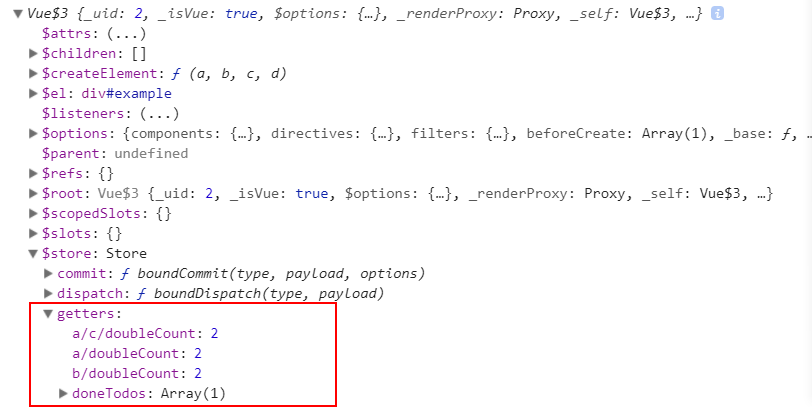
局部化state:
state的局部化时在前述的local对象上定义state属性,并重新定义该属性的get函数:
state: {
get: function () { return getNestedState(store.state, path); }
}
它会调用getNestedState方法由根实例的state向下查找对应命名空间的state, getNestedState定义在VUEX源码的757 ~ 761 行:
function getNestedState (state, path) {
return path.length
? path.reduce(function (state, key) { return state[key]; }, state)
: state
}
以上面的例子为例,我们来看一下a模块和c模块的state关系就知道了:

所有的局部化完成之后会将该local对象返回,挂载在根模块的context属性上:
return local
我们来看看例子:
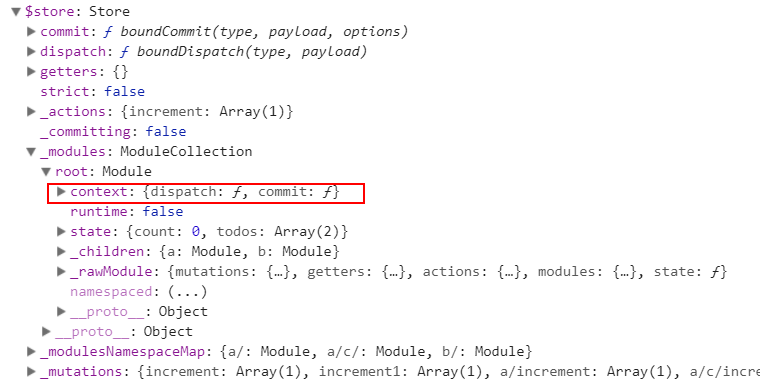
回过头来继续看installModule函数的执行,它会分别遍历mutaions, actions, getters,并分别执行registerMutation,registerAction,registerGetter:
module.forEachMutation(function (mutation, key) {
var namespacedType = namespace + key;
registerMutation(store, namespacedType, mutation, local);
});
module.forEachAction(function (action, key) {
var type = action.root ? key : namespace + key;
var handler = action.handler || action;
registerAction(store, type, handler, local);
});
module.forEachGetter(function (getter, key) {
var namespacedType = namespace + key;
registerGetter(store, namespacedType, getter, local);
});
我们来分别看一下:
注册Mutation:
注册mutaion首先会调用forEachMutation进行遍历:
module.forEachMutation(function (mutation, key) {
var namespacedType = namespace + key;
registerMutation(store, namespacedType, mutation, local);
});
forEachMutation的实现在VUEX源码的161 ~ 165行:
Module.prototype.forEachMutation = function forEachMutation (fn) {
if (this._rawModule.mutations) {
forEachValue(this._rawModule.mutations, fn);
}
};
forEachValue的实现我们在前面讲过,实际上就是遍历对象的key,将value,key作为参数应用于fn。而对于forEachAction而言,它的fn就是:
function (action, key) {
var type = action.root ? key : namespace + key;
var handler = action.handler || action;
registerAction(store, type, handler, local);
}
这里的核心还是归结到使用命名空间注册action了,它实际调用的是registerAction,该函数定义在VUEX源码的700 ~ 705 行:
function registerMutation (store, type, handler, local) {
var entry = store._mutations[type] || (store._mutations[type] = []);
entry.push(function wrappedMutationHandler (payload) {
handler.call(store, local.state, payload);
});
}
实际上,它是在根store的_mutaions上以命名空间为key,注册对应的mutaion。稍后我们会有实际例子展示。
注册Action:
同注册Mutation原理一模一样,注册action首先会调用forEachAction进行遍历:
module.forEachAction(function (action, key) {
var type = action.root ? key : namespace + key;
var handler = action.handler || action;
registerAction(store, type, handler, local);
});
forEachAction的实现在VUEX源码的155 ~ 159行:
Module.prototype.forEachAction = function forEachAction (fn) {
if (this._rawModule.actions) {
forEachValue(this._rawModule.actions, fn);
}
};
forEachValue的实现我们在前面讲过,实际上就是遍历对象的key,将value,key作为参数应用于fn。而对于forEachMutation而言,它的fn就是:
function (mutation, key) {
var namespacedType = namespace + key;
registerMutation(store, namespacedType, mutation, local);
}
这里的核心还是归结到使用命名空间注册mutation了,它实际调用的是registerMutation,该函数定义在VUEX源码的707 ~ 730 行:
function registerAction (store, type, handler, local) {
var entry = store._actions[type] || (store._actions[type] = []);
entry.push(function wrappedActionHandler (payload, cb) {
var res = handler.call(store, {
dispatch: local.dispatch,
commit: local.commit,
getters: local.getters,
state: local.state,
rootGetters: store.getters,
rootState: store.state
}, payload, cb);
if (!isPromise(res)) {
res = Promise.resolve(res);
}
if (store._devtoolHook) {
return res.catch(function (err) {
store._devtoolHook.emit('vuex:error', err);
throw err
})
} else {
return res
}
});
}
实际上,它是在根store的_actions上以命名空间为key,注册对应的action。但是action比mutaion复杂,主要体现在:
- 在分发action时可以提供一个callback。
- 在实际action的执行时,action的handle的参数会更复杂。
对于第二点,从代码中,我们可以看出,action实际上的会暴露四个参数:
- 根级别的store。
- 局部化的以及根级别的一些内容。这其中包括局部化的dispatch、commit、getters、state,根级别的getters、state。
- 分发action时的载荷。
- 分发action时的callback。
action和mutations的最大区别还在于,action是支持异步的。这在上述代码也有体现。
稍后我们会有实际例子展示注册action的效果。
注册Getters:
同注册Mutation、Action原理类似,注册getters首先会调用forEachGetter进行遍历:
module.forEachGetter(function (getter, key) {
var namespacedType = namespace + key;
registerGetter(store, namespacedType, getter, local);
});
forEachGetter的实现在VUEX源码的149 ~ 153行:
Module.prototype.forEachGetter = function forEachGetter (fn) {
if (this._rawModule.getters) {
forEachValue(this._rawModule.getters, fn);
}
};
forEachValue的实现我们在前面讲过,实际上就是遍历对象的key,将value,key作为参数应用于fn。而对于forEachGetter而言,它的fn就是:
function (getter, key) {
var namespacedType = namespace + key;
registerGetter(store, namespacedType, getter, local);
}
这里的核心还是归结到使用命名空间注册getters了,它实际调用的是registerGetter,该函数定义在VUEX源码的732 ~ 747 行:
function registerGetter (store, type, rawGetter, local) {
if (store._wrappedGetters[type]) {
{
console.error(("[vuex] duplicate getter key: " + type));
}
return
}
store._wrappedGetters[type] = function wrappedGetter (store) {
return rawGetter(
local.state, // local state
local.getters, // local getters
store.state, // root state
store.getters // root getters
)
};
}
实际上,它是在根store的_wrappedGetters上以命名空间为key,注册对应的getters。它实际上是对getters对应的handle参数做了处理,暴露出四个参数:局部化的state、局部化的getters、根级别的state、根级别的getters。
以上Mutation、Action、Getters的注册可以通过下面这个例子来加深理解:
const moduleC = {
namespaced: true,
state: { count: 1, age1: 20 },
mutations: {
increment (state) {
// 这里的 `state` 对象是模块的局部状态
state.count++
}
},
getters: {
doubleCount (state) {
return state.count * 2
}
}
}
const moduleA = {
namespaced: true,
state: { count: 1, age1: 20 },
mutations: {
increment (state) {
// 这里的 `state` 对象是模块的局部状态
state.count++
}
},
actions: {
increment (context) {
context.commit('increment')
}
},
getters: {
doubleCount (state) {
return state.count * 2
}
},
modules: {
c: moduleC
}
}
const moduleB = {
namespaced: true,
state: { count: 1, age1: 20 },
mutations: {
increment (state) {
// 这里的 `state` 对象是模块的局部状态
state.count++
}
},
actions: {
increment (context) {
context.commit('increment')
}
},
getters: {
doubleCount (state) {
return state.count * 2
}
}
}
const store = new Vuex.Store({
state() {
return {
count: 0,
todos: [
{ id: 1, text: '...', done: true },
{ id: 2, text: '...', done: false }
]
}
},
mutations: {
increment (state) {
state.count++
},
increment1 (state) {
state.count++
}
},
getters: {
doneTodos: state => {
return state.todos.filter(todo => todo.done)
}
},
actions: {
increment (context) {
context.commit('increment')
}
},
modules: {
a: moduleA,
b: moduleB
}
})
var vm = new Vue({
el: '#example',
data: {
age: 10
},
store,
mounted() {
console.log(this.count)
this.localeincrement('hehe')
console.log(this.count)
},
// computed: Vuex.mapState('a', [
// 'count', 'age1'
// ]
// ),
computed: Vuex.mapState([
'count'
]
),
methods: {
...Vuex.mapMutations({
add: 'increment' // 将 `this.add()` 映射为 `this.$store.commit('increment')`
}),
...Vuex.mapMutations({
localeincrement (commit, args) {
console.log(commit)
console.log(args)
commit('increment', args)
}
})
}
})
console.log(vm)
分别看看注册的结果:
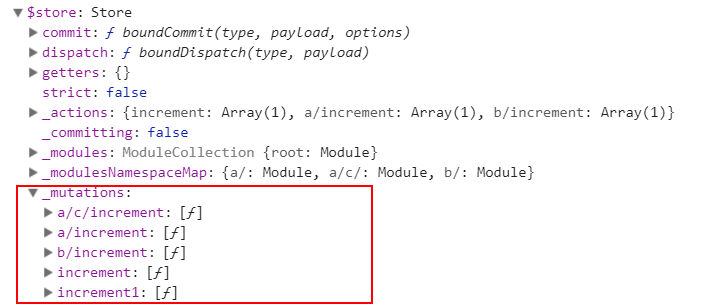
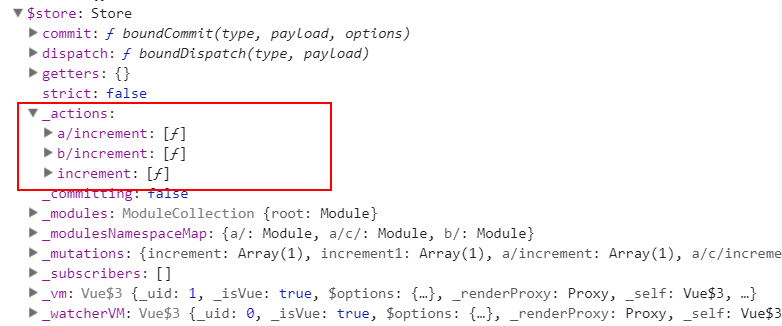
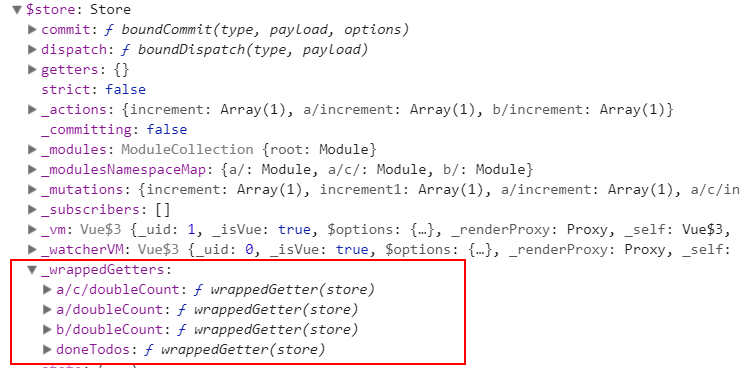
回过头来继续看installModule的执行,它会遍历该模块的子模块,递归调用installModule来完成上述注册:
module.forEachChild(function (child, key) {
installModule(store, rootState, path.concat(key), child, hot);
});
而forEachChild定义在VUEX源码的145 ~ 147 行:
Module.prototype.forEachChild = function forEachChild (fn) {
forEachValue(this._children, fn);
};
至此,installModule的执行就jies 了,我们回过头继续看看Store类的构造函数执行,接下来执行的是resetStoreVM函数,它定义在VUEX源码的531 ~ 575 行:
function resetStoreVM (store, state, hot) {
var oldVm = store._vm;
// bind store public getters
store.getters = {};
var wrappedGetters = store._wrappedGetters;
var computed = {};
forEachValue(wrappedGetters, function (fn, key) {
// use computed to leverage its lazy-caching mechanism
computed[key] = function () { return fn(store); };
Object.defineProperty(store.getters, key, {
get: function () { return store._vm[key]; },
enumerable: true // for local getters
});
});
// use a Vue instance to store the state tree
// suppress warnings just in case the user has added
// some funky global mixins
var silent = Vue.config.silent;
Vue.config.silent = true;
store._vm = new Vue({
data: {
$$state: state
},
computed: computed
});
Vue.config.silent = silent;
// enable strict mode for new vm
if (store.strict) {
enableStrictMode(store);
}
if (oldVm) {
if (hot) {
// dispatch changes in all subscribed watchers
// to force getter re-evaluation for hot reloading.
store._withCommit(function () {
oldVm._data.$$state = null;
});
}
Vue.nextTick(function () { return oldVm.$destroy(); });
}
}
它实际上主要做的是在store的实例上定义vm属性,而vm上挂载的是一个新的Vue实例,这个vue实例的data为store的state,而computed为store的getters,我们同样以前面的那个例子,看看效果:
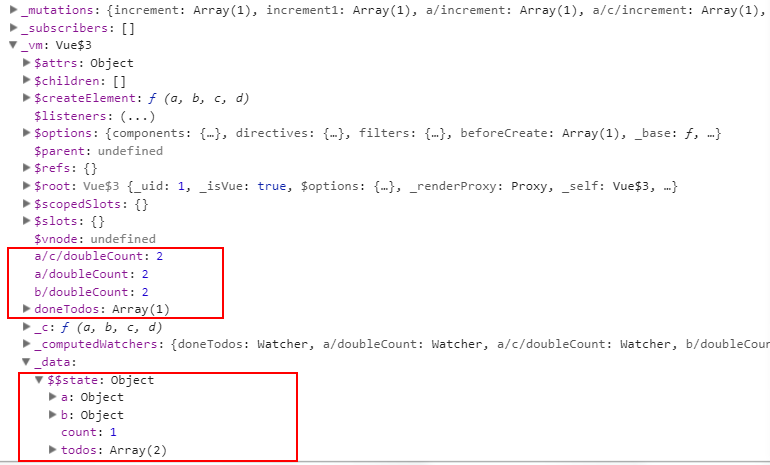
Store构造函数的最后是和插件、调试工具有关的几行代码,这里不再细述:
// apply plugins
plugins.forEach(function (plugin) { return plugin(this$1); });
if (Vue.config.devtools) {
devtoolPlugin(this);
}
4.2 原型函数
4.2.1 Store.prototype.commit
commit定义在VUEX源码的376 ~ 409行:
Store.prototype.commit = function commit (_type, _payload, _options) {
var this$1 = this;
// check object-style commit
var ref = unifyObjectStyle(_type, _payload, _options);
var type = ref.type;
var payload = ref.payload;
var options = ref.options;
var mutation = { type: type, payload: payload };
var entry = this._mutations[type];
if (!entry) {
{
console.error(("[vuex] unknown mutation type: " + type));
}
return
}
this._withCommit(function () {
entry.forEach(function commitIterator (handler) {
handler(payload);
});
});
this._subscribers.forEach(function (sub) { return sub(mutation, this$1.state); });
if (
"development" !== 'production' &&
options && options.silent
) {
console.warn(
"[vuex] mutation type: " + type + ". Silent option has been removed. " +
'Use the filter functionality in the vue-devtools'
);
}
};
它所做的就是当mutation被提交时执行对应的函数,并且还会执行订阅列表里面的回调函数。
4.2.2 Store.prototype.dispatch
dispatch定义在VUEX源码的411 ~ 433 行,它的原理和commit基本上一样的,也是在分发action时执行对应的函数,并且执行订阅action的列表,所不同的是action是支持异步的:
Store.prototype.dispatch = function dispatch (_type, _payload) {
var this$1 = this;
// check object-style dispatch
var ref = unifyObjectStyle(_type, _payload);
var type = ref.type;
var payload = ref.payload;
var action = { type: type, payload: payload };
var entry = this._actions[type];
if (!entry) {
{
console.error(("[vuex] unknown action type: " + type));
}
return
}
this._actionSubscribers.forEach(function (sub) { return sub(action, this$1.state); });
return entry.length > 1
? Promise.all(entry.map(function (handler) { return handler(payload); }))
: entry[0](payload)
};
4.2.3 Store.prototype.subscribe
subscribe定义在VUEX源码的435 ~ 437行,用于注册订阅mutation的回调:
Store.prototype.subscribe = function subscribe (fn) {
return genericSubscribe(fn, this._subscribers)
};
官方描述如下:
注册监听 store 的 mutation。handler 会在每个 mutation 完成后调用,接收 mutation 和经过 mutation 后的状态作为参数:
store.subscribe((mutation, state) => { console.log(mutation.type) console.log(mutation.payload) })通常用于插件。
它实际上调用的是定义在VUEX源码507 ~ 517行的genericSubscribe函数:
function genericSubscribe (fn, subs) {
if (subs.indexOf(fn) < 0) {
subs.push(fn);
}
return function () {
var i = subs.indexOf(fn);
if (i > -1) {
subs.splice(i, 1);
}
}
}
它实际上就是订阅mutation,并将回调放入_subscribers订阅列表中,它会返回一个函数,用于解除订阅。这个主要用在调试工具里。
4.2.4 Store.prototype.subscribeAction
subscribeAction定义在VUEX源码的439 ~ 441行,用于注册订阅action的回调,它和subscribe函数的原理是一模一样的:
Store.prototype.subscribeAction = function subscribeAction (fn) {
return genericSubscribe(fn, this._actionSubscribers)
};
它实际上也调用的是定义在VUEX源码507 ~ 517行的genericSubscribe函数,这个在前面已经讲过了。它实际上就是订阅action,并将回调放入_actionSubscribers订阅列表中,它会返回一个函数,用于解除订阅。这个也主要用在调试工具里。
4.2.5 Store.prototype.watch
watch定义在VUEX源码的433 ~ 450行:
Store.prototype.watch = function watch (getter, cb, options) {
var this$1 = this;
{
assert(typeof getter === 'function', "store.watch only accepts a function.");
}
return this._watcherVM.$watch(function () { return getter(this$1.state, this$1.getters); }, cb, options)
};
我们来直接看看官方文档对它的解释吧:
响应式地监测一个 getter 方法的返回值,当值改变时调用回调函数。getter 接收 store 的状态作为唯一参数。接收一个可选的对象参数表示 Vue 的 vm.$watch 方法的参数。
要停止监测,直接调用返回的处理函数。
4.2.6 Store.prototype.replaceState
replcaeState定义在VUEX源码的452 ~ 489行,用于替换_vm属性上存储的状态:
Store.prototype.replaceState = function replaceState (state) {
var this$1 = this;
this._withCommit(function () {
this$1._vm._data.$$state = state;
});
};
4.2.7 Store.prototype.registerModule
registerModule定义在VUEX源码的第460 ~ 474 行,使得Store实例能够在给定路径注册相应的模块,实际上还是从根模块开始,找到对应的路径,然后注册。注册完成后需要重新安装模块,然后重置_vm属性:
Store.prototype.registerModule = function registerModule (path, rawModule, options) {
if ( options === void 0 ) options = {};
if (typeof path === 'string') { path = [path]; }
{
assert(Array.isArray(path), "module path must be a string or an Array.");
assert(path.length > 0, 'cannot register the root module by using registerModule.');
}
this._modules.register(path, rawModule);
installModule(this, this.state, path, this._modules.get(path), options.preserveState);
// reset store to update getters...
resetStoreVM(this, this.state);
};
4.2.8 Store.prototype.unregisterModule
unregisterModule定义在VUEX源码的第476 ~ 491行,它使得Store实例可以通过提供的path参数解除对应模块的注册。实际上它还是根据path找到对应的模块的父模块,然后调用父模块的unregister方法完成解绑:
Store.prototype.unregisterModule = function unregisterModule (path) {
var this$1 = this;
if (typeof path === 'string') { path = [path]; }
{
assert(Array.isArray(path), "module path must be a string or an Array.");
}
this._modules.unregister(path);
this._withCommit(function () {
var parentState = getNestedState(this$1.state, path.slice(0, -1));
Vue.delete(parentState, path[path.length - 1]);
});
resetStore(this);
};
4.2.9 Store.prototype.hotUpdate
hotUpdate定义在VUEX源码的493 ~ 496行:
Store.prototype.hotUpdate = function hotUpdate (newOptions) {
this._modules.update(newOptions);
resetStore(this, true);
};
hotUpdate可以热更新整个模块,跟新完后调用resetStore重置整个模块,resetStore的定义在519 ~ 529行:
function resetStore (store, hot) {
store._actions = Object.create(null);
store._mutations = Object.create(null);
store._wrappedGetters = Object.create(null);
store._modulesNamespaceMap = Object.create(null);
var state = store.state;
// init all modules
installModule(store, state, [], store._modules.root, true);
// reset vm
resetStoreVM(store, state, hot);
}
可以看到基本上就是将构造函数推倒重来了一遍。
4.2.10 Store.prototype._withCommit
_withCommit定义在VUEX源码的498 ~ 503行:
Store.prototype._withCommit = function _withCommit (fn) {
var committing = this._committing;
this._committing = true;
fn();
this._committing = committing;
};
它首先设置当前store的committing状态为true,表示正在commit,然后执行对应的函数,当执行完毕后,重置commit状态。